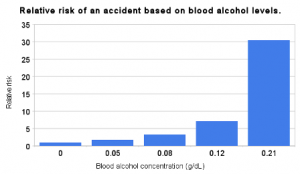You can not drink alcohol and drive a motor vehicle safely. Period.
We are fast approaching “tis the season” with Thanksgiving, Christmas and New Years nearly upon us and it is a good time to remind ourselves of important aspects of being safe while making jolly.
Think about it. You are at a party. You have a drink and then a couple more. Your inhibitions drop…your judgment is impaired. It is exactly what we know the alcohol does and driving at that point should not be expected to go well at all.
But, people still get behind the wheel too often when they should be calling a taxi or a friend. Sadly, EVERY injury or death caused by drunk driving is completely preventable.
 The legal limit for determining whether you are impaired in Florida is a .08 blood/alcohol level (BAC) and if you are under 21 years old, it is a .02 blood alcohol level. Blood alcohol level is a method of expressing the amount of alcohol in a person’s blood system at any given time. A BAC of .08 means that .08% of a person’s total blood volume contains alcohol.
The legal limit for determining whether you are impaired in Florida is a .08 blood/alcohol level (BAC) and if you are under 21 years old, it is a .02 blood alcohol level. Blood alcohol level is a method of expressing the amount of alcohol in a person’s blood system at any given time. A BAC of .08 means that .08% of a person’s total blood volume contains alcohol.
The amount of alcohol called for in most state’s to categorize someone as intoxicated does not seem like a great deal on the surface. Let’s look at the progression of blood/alcohol level and the response to that alcohol in most people:
.03 – .059 mild euphoria, decreased inhibition and impaired concentration
.06 – .09 impaired reasoning, depth perception, impaired peripheral vision and difficulty in recovering from light glare
.10 – .19 impaired reflexes, slower reaction times, and impaired gross motor control
.20 – .29 severe motor impairment, memory blackout and loss of consciousness
How much is too much? Putting aside for the moment that when behind the wheel, any is too much, It is difficult to predict because so many variables affect blood alcohol level:
- The type of alcohol being drank;
- Food intake;
- Level of fitness;
- The weight of the person;
- The amount of body fat the person has;
- The sex of the person; and
- The number of drinks consumed in a given time period.
Know this: the number of drinks ingested is a poor measure of intoxication. In addition, if you have been drinking, you are a poor judge of the level of your intoxication or your ability to react in a 4000 pound piece of metal moving at any speed.
If we look at (5) large counties in the State of Florida, in 2006, 14,132 people were convicted of driving under the influence (DUI) of alcohol, drugs or both. In the same year, 1,111 people were killed in alcohol related crashes on Florida roadways. Realistically, that 1,111 number could have been horrifically higher and, had Florida law enforcement not been successful in getting over 14,000 impaired drivers off the roadway, the death toll might have reached into the multiple thousands dead as a result of the combination of alcohol and motor vehicles.
But even with dedicated law enforcement officers trying to keep roads safe, there were 10,389 fatalities resulting from alcohol impaired driving in the United States in 2009. In Florida, in 2009, there were 904 fatalities, representing nearly 10% of the entire country total for that year.
So, what else can be done besides each of us demonstrating personal responsibility? Here are some recommendations from noted experts:
- DWI courts, sometimes called DUI courts, sobriety courts, wellness courts or accountability courts have proven effective in reducing the crime of drunken driving.
- Automatic license revocation.
- Impounding or confiscating license plates.
- Mandating the installation of interlock devices that prevent intoxicated persons from starting a vehicle.
- Volunteer to be a designated driver.
- Always use a safety seat belt.
- Use four-lane highways whenever possible.
- Avoid rural roads.
- Avoid travel after midnight (especially on Fridays and Saturdays).
- Never drive when fatigued. The dangers posed when fatigued are similar to those when intoxicated. A drunk or fatigued driver has slowed reactions and impaired judgment. And a driver who nods off at the wheel has no reactions and no judgment! Drivers who drift off cause about 72,500 injuries and deaths each and every year.
- Steer clear of aggressive drivers. Aggressive drivers may be responsible for more deaths than drunk drivers.
The best prevention from a drunken driving incident? Don’t drink and drive; don’t let friends drink and drive; don’t ride in a vehicle with someone who has been drinking and report drivers you observe on the roadways if you suspect they may be impaired.
Share This


